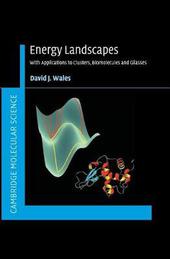
|
Energy Landscapes: Applications to Clusters, Biomolecules and Glasses
Hardback
Main Details
| Title |
Energy Landscapes: Applications to Clusters, Biomolecules and Glasses
|
| Authors and Contributors |
By (author) David Wales
|
| Series | Cambridge Molecular Science |
|---|
| Physical Properties |
| Format:Hardback | | Pages:692 | | Dimensions(mm): Height 255,Width 182 |
|
| ISBN/Barcode |
9780521814157
|
| Classifications | Dewey:541.2 |
|---|
| Audience | | Professional & Vocational | | Tertiary Education (US: College) | |
|---|
| Illustrations |
110 Plates, color; 150 Line drawings, unspecified
|
|
Publishing Details |
| Publisher |
Cambridge University Press
|
| Imprint |
Cambridge University Press
|
| Publication Date |
22 January 2004 |
| Publication Country |
United Kingdom
|
Description
The study of energy landscapes holds the key to resolving some of the most important contemporary problems in chemical physics. Many groups are now attempting to understand the properties of clusters, glasses and proteins in terms of the underlying potential energy surface. The aim of this book is to define and unify the field of energy landscapes in a reasonably self-contained exposition. This is the first book to cover this active field. The book begins with an overview of each area in an attempt to make the subject matter accessible to workers in different disciplines. The basic theoretical groundwork for describing and exploring energy landscapes is then introduced followed by applications to clusters, biomolecules and glasses in the final chapters. Beautifully illustrated in full colour throughout, this book is aimed at graduate students and workers in the field.
Author Biography
David Wales is a lecturer in the Department of Chemistry at Cambridge University.
Reviews'This beautifully illustrated book provides a detailed background and description of energy landscapes and gives many examples of how they can be used to explain the properties of atomic and molecular clusters, biomolecules, glasses, and supercooled liquids ... Energy Landscapes provides a pictorial language that simplifies complicated calculations to a form that can be understood and used by many scientists interested in molecular problems, from undergraduates to those at the frontier of research.' Science Magazine 'Since this is the first book published in this very active field, it should serve as a reference source for a long time, and will be a very valuable resource for young scientists to become acquainted with the study of the PES of complex systems.' Angewandte Chemie '... the energy landscape community ... owes a great debt to Dr Wales for producing a detailed yet eminently readable book that will serve as the standard reference for many years to come ... the author is to be recommended for tackling this important and vase area and for presenting it in a lucid and unified picture. The author's clear and gentle style make the book accessible to undergraduates, while the depth of coverage and the insights that are generously sprinkled throughout the book will make it invaluable to researchers in the field ... On many occasions I found myself picking up the book just for random browsing and the sheer enjoyment of the clear discussion and beautiful presentation.' Physics in Canada ' ... Wales' book defines a whole new subject, even more - a whole new field, and at the same time presents its state of the art description ... a superb and laudable achievement, and I believe it will represent a resource on the subject of PES for years to come ... I can certainly recommend it as an exhaustive guide and treasure trove of resources in the fascinating worlds of PES ... a first class achievement ... in many respects a beautiful, well conceived and most informative book. It moves elegantly and engagingly through various fields of theoretical physics, physical chemistry and molecular biology to expose and explain the unifying workings of the potential energy surfaces and along the way finds an elegant and meaningful connection, on a most fundamental level, between the worlds of nano and bioscience in a way hardly attempted before.' Journal of Statistical Physics
|